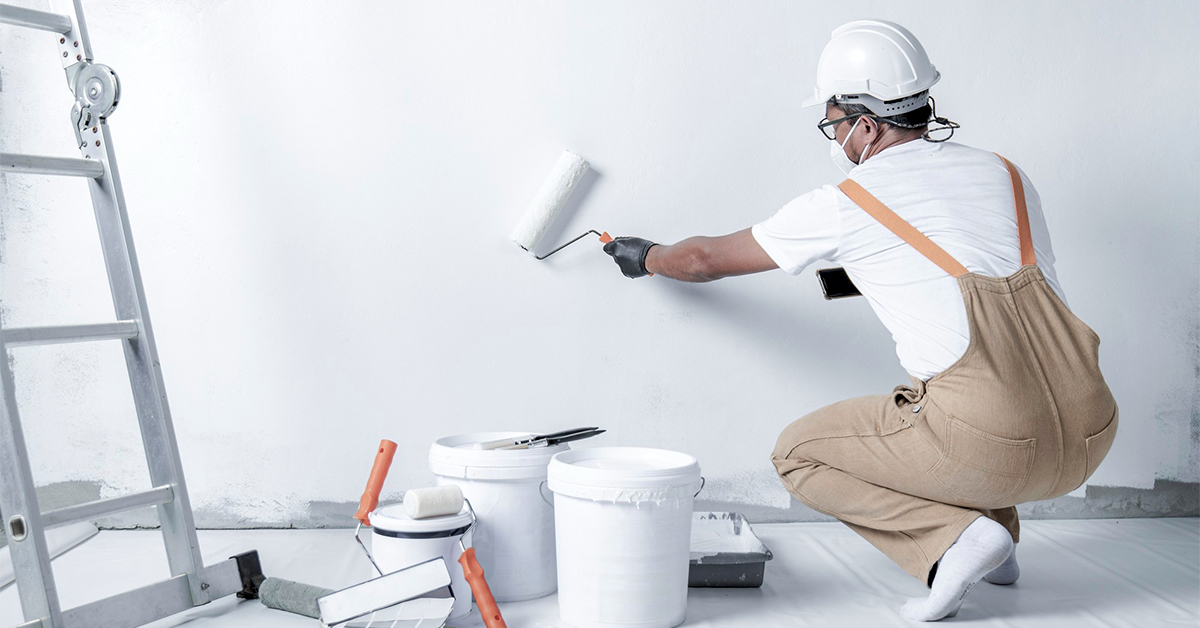Discovering the Different Sorts Of Paint: A Guide for Every Job
Exploring the different sorts of paint is crucial for accomplishing the wanted result in any job. From water-based options that supply comfort to oil-based paints recognized for their longevity, each option has its benefits. Specialized paints can include distinct textures or surfaces, while eco-friendly options accommodate those seeking sustainability. Recognizing these distinctions can substantially affect the success of a painting venture. What variables should one consider when making the ideal choice?
Comprehending Paint Kinds: Water-Based vs. Oil-Based
Paint types can markedly influence a project's outcome, and comprehending the distinctions between water-based and oil-based paints is necessary for informed decision-making. Water-based paints, typically described as latex paints, are composed of water as the primary solvent. They dry swiftly, emit fewer unpredictable organic substances (VOCs), and are simple to clean up with soap and water. This makes them a preferred choice for interior applications and atmospheres where air top quality is a concern.
In contrast, oil-based paints use organic solvents, offering a long lasting, shiny coating perfect for surfaces exposed to deterioration, such as trim and cupboards. They take longer to completely dry, call for mineral spirits for clean-up, and have a more powerful smell. corpus christi paint store. Selecting between these two types depends on the specific requirements of the project, considering elements such as desired finish, application environment, and ease of maintenance. Each kind has unique benefits and constraints, assisting the choice process
The Complete Matters: Picking In Between Matte, Satin, and Gloss
When picking a paint finish, the choice between matte and shiny alternatives substantially influences both looks and capability. Matte surfaces provide a refined, non-reflective look that can conceal surface area blemishes, while glossy finishes provide resilience and ease of cleansing. Recognizing the benefits and factors to consider of each can assist in making a notified decision for any kind of painting project.
Matte Finish Advantages
Although several home owners dispute the values of different finishes, matte paint offers distinctive benefits that make it a prominent choice for both exterior and interior applications. One of the key benefits of matte coating is its ability to conceal surface blemishes, producing a smoother appearance on wall surfaces. This high quality is particularly helpful in older homes or spaces with unequal surfaces. Furthermore, matte paint takes in light instead of showing it, which can enhance the visual of an area by offering a more soft and sophisticated look. Matte coatings are typically easier to touch up than glossier alternatives, as they can blend a lot more flawlessly when applied over existing paint. In general, matte paint is an exceptional selection for those looking for an improved and stylish surface.
Shiny Complete Factors To Consider
A shiny coating can significantly alter the assumption of a room, supplying a reflective and smooth high quality that boosts both shade vibrancy and light within an area. This finish is frequently favored for high-traffic locations and surface areas like bathroom and kitchens, where resilience and ease of cleaning are important. Its reflective nature can highlight flaws on wall surfaces, making proper surface prep work critical. Glossy paints also tend to show spots and finger prints more easily, necessitating regular upkeep. Additionally, illumination plays a considerable role; in bright environments, a glossy coating might develop glow, affecting the general aesthetic. Consequently, cautious consideration of the specific application and environment is essential when picking a shiny surface for any project.
Specialized Paints: When to Utilize Textured or Chalk Paint
Specialized paints, such as textured and chalk paint, offer one-of-a-kind visual and useful benefits that can enhance various surface areas. Distinctive paint is suitable for creating depth and dimension on walls, hiding imperfections while including a three-dimensional feel. It is particularly helpful in high-traffic locations where resilience and visual passion are vital.

Both sorts of specialized paints can change rooms, yet picking the right one depends on the preferred result and surface requirements. Textured paint may suit larger areas, while chalk paint can revitalize smaller sized products, showcasing creative thinking and personal style in any project.
Exterior Paints: Protecting Your Surfaces From the Components
Outside paints are necessary for securing surface areas against different weather condition conditions. Comprehending their weather condition resistance functions, appropriate surface preparation demands, and efficient application strategies can considerably boost toughness and efficiency. This area will certainly detail crucial considerations for selecting and using outside paints successfully.
Weather Condition Resistance Features
Weather resistance is an important feature of exterior paints, as it establishes exactly how well surfaces can withstand the severe elements of nature. Premium outdoor paints are developed to resist damages from UV rays, dampness, and temperature fluctuations. UV resistance warranties shades remain vibrant with time, protecting against fading and staining. Moisture resistance shields versus mold and mold, which can jeopardize the integrity of surface areas. Furthermore, paints with superb temperature level resistance can acquire and expand without fracturing, preserving their safety high qualities. When selecting outdoor paints, it is essential to think about these weather condition resistance functions, as they add to the longevity and durability of coloured surfaces, making particular they remain cosmetically pleasing and practical regardless of exposure to the components.
Surface Preparation Requirements
Appropriate surface area preparation is a basic step in attaining the very best outcomes with outdoor paints. To ensure optimal adhesion and toughness, surfaces should be extensively cleaned, eliminating mildew, grease, and dirt. This can be completed using a stress washer or a scrub brush click this site with a suitable cleansing solution. When cleaned up, surface areas ought to be checked for any peeling or flaking paint, which should be scraped away to create a smooth structure. Fixing any kind of splits or openings is additionally important, as these can enable dampness seepage. Furthermore, fining sand harsh areas promotes better paint attachment. Using a guide suited for outdoor usage can boost the paint's performance, guaranteeing a long-lasting finish that endures the aspects. Appropriate preparation is essential to a successful outside painting task.
Application Techniques Tips
While using exterior paints, it is essential to utilize effective techniques that guarantee surface areas are well-protected versus the aspects. First, select the best day for painting; low moisture and light temperature levels improve attachment and drying out. Prepping the surface area thoroughly-- cleansing, sanding, and priming-- makes sure better paint adhesion and resilience. Using top quality brushes or rollers can provide a smoother finish, while spray paint may cover large locations efficiently. Applying paint in slim, even coats protects against runs and drips. It is a good idea to follow maker instructions relating to drying times between layers. Verify appropriate air flow during application to assist in drying out and reduce exposure to fumes. These strategies greatly boost the long life and effectiveness of outside paint.
Eco-Friendly Options: Low-VOC and Zero-VOC Paints
As consumers come to be significantly familiar with the environmental effect of their choices, low-VOC and zero-VOC paints have become prominent alternatives. These paints are created to include less volatile natural substances (VOCs), which are chemicals that can evaporate right into the air and add to air contamination and illness. Low-VOC paints typically consist of a limited amount of VOCs, while zero-VOC paints have minimal degrees, making them more secure for both outdoor and indoor use.
The advantages of utilizing low-VOC and zero-VOC paints expand past environmental considerations; they also boost interior air top quality, decreasing the risk of sensitive reactions and breathing problems. Lots of makers currently offer a selection of shades and finishes in environmentally friendly alternatives, making it simpler for consumers to discover ideal products for their projects. By deciding for these paints, individuals can contribute to a much healthier atmosphere while still achieving the aesthetic they desire in their spaces.
Devices and Techniques for a Flawless Application
Achieving a remarkable paint application needs the right tools and strategies, which can significantly enhance the outcome. Picking the ideal brush or roller is crucial; brushes function well for sides and detailed areas, while rollers cover bigger surfaces successfully. Making use of high-quality materials guarantees better paint circulation and lessens touches. For excellent outcomes, surface area prep work is necessary. This includes cleansing, sanding, and priming surface areas to promote bond.
Method also plays a substantial role. The "W" approach with a roller assists to equally disperse paint, while long, smooth strokes with a brush stop visible lines. Operating in areas permits much better control and blending. Additionally, using slim coats is more suitable to thick layers, decreasing the risk of drips and uneven textures. Preserving a wet side during application aids attain smooth changes in between areas. By combining these devices and methods, one can achieve a specialist and polished coating.
Tips for Keeping and Caring for Your Painted Surfaces
Proper maintenance and care of colored surface areas can substantially extend their lifespan and preserve their appearance. Regular cleaning is necessary; making use of a soft towel or sponge with mild soap and water can get rid of dirt and dirt without damaging the paint. It is a good idea to stay clear of rough cleansers or rubbing pads, as these can scratch the surface. Additionally, using a fresh layer of paint every few years can rejuvenate the shade and safeguard against wear.
For outside surfaces, evaluating for signs of peeling off or fading routinely is necessary. Promptly addressing any type of problems prevents additional damages. In areas susceptible to wetness, such as restrooms, utilizing mold-resistant paint and guaranteeing correct ventilation can help keep the integrity of the paint. Utilizing safety finishes can shield against UV rays and spots, making sure that repainted surfaces continue to be dynamic and appealing for years to come, eventually improving the overall aesthetic of the area.

Frequently Asked Inquiries
Can I Mix Different Types of Paint Together?
Blending various kinds of paint is generally not recommended, as it can bring about problems like bad adhesion, irregular texture, or unanticipated chemical reactions. It's best to utilize compatible paints for suitable results and durability.

Just how Do I Properly Shop Surplus Paint?
To appropriately keep leftover paint, secure the container tightly, tag it with the day and color, and keep it in a great, dry place away from direct sunshine and severe temperatures for suitable preservation.
What Is the most effective Method to Get Rid Of Extra Paint?
The finest means to take care of unused paint is to check neighborhood regulations, as numerous areas have marked contaminated materials centers. Think about donating usable paint to community organizations or colleges for their jobs.
Exactly How Can I Inform if Paint Is Still Great to Make Use Of?
To identify if paint is still good, analyze its consistency, color, and scent. If it visite site appears separated, has an unpleasant smell, or shows significant modifications in texture, it's most likely no more usable.
Are There Age Restrictions for Purchasing Paint Products?
In several areas, there are no particular age restrictions for buying paint items. Nevertheless, some shops might call for consumers to be a minimum of 18 years old, particularly for products including solvents or harmful products.
Paint types can considerably influence a task's outcome, and recognizing the distinctions between oil-based and water-based paints this article is crucial for educated decision-making. Water-based paints, typically referred to as latex paints, are made up of water as the key solvent. In contrast, oil-based paints make use of natural solvents, supplying a durable, shiny coating ideal for surfaces subjected to tear and put on, such as trim and closets. Specialized paints, such as distinctive and chalk paint, offer distinct aesthetic and useful advantages that can boost numerous surfaces. In areas susceptible to moisture, such as shower rooms, making use of mold-resistant paint and making sure correct air flow can assist keep the honesty of the paint.